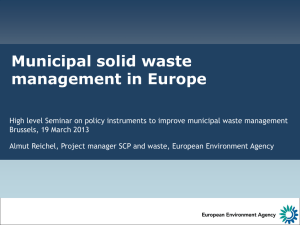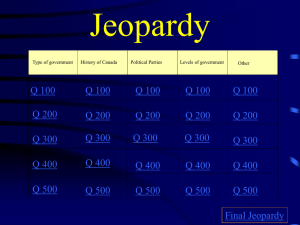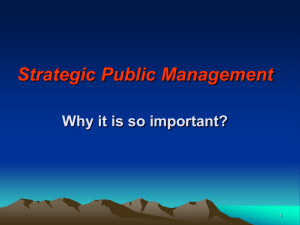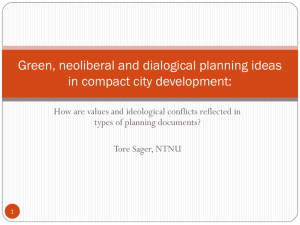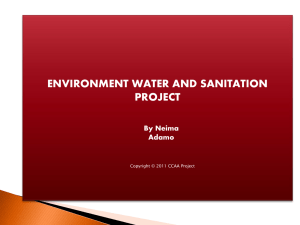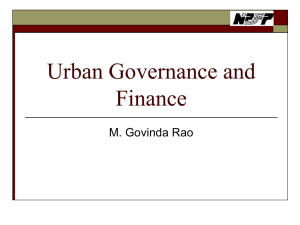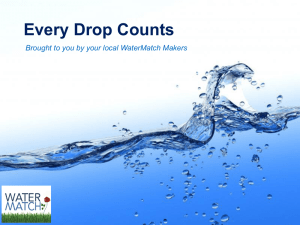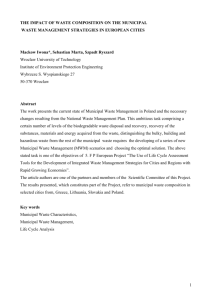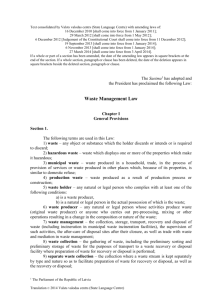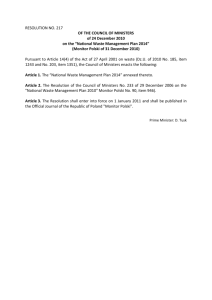the act
advertisement
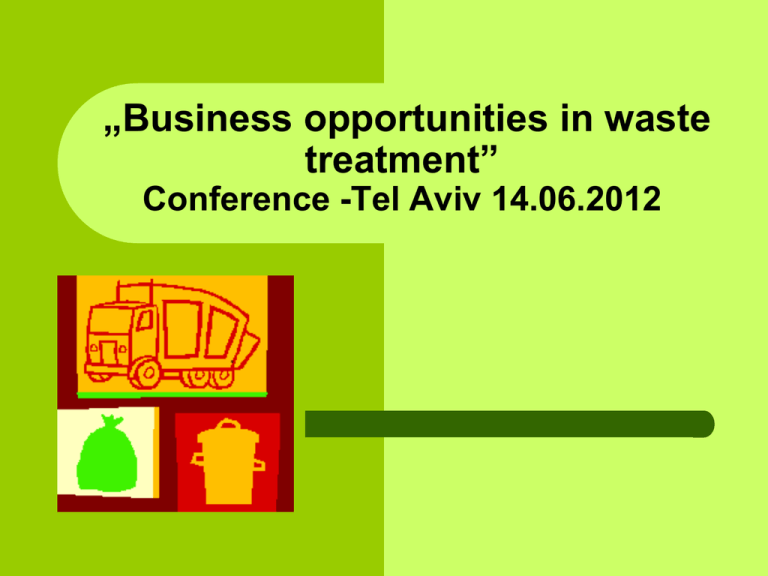
„Business opportunities in waste treatment” Conference -Tel Aviv 14.06.2012 Business opportunities in waste treatment - introduction Existing situation, circumstances: - formal - institutional / organisational National waste management plan - main objectives Waste is the problem ! - it‘s true - so where the business is ??? Legislation the act of 27 April 2001 on waste (Official Journal of 2010 No. 185, item 1243, further amended ), the act of 11 May 2001 on the operators' responsibilities in the scope of managing certain types of waste and the product charge (Official Journal of 2007 No. 90, item 607, further amended), the act of 29 July 2005 on waste electrical and electronic equipment (Official Journal of 2005 r. No. 180, item 1495, further amended), the act of 24 April 2009 on batteries and accumulators (Official Journal of 2009 No. 79, item 666, further amended), Legislation the act of 20 January 2005 on the recycling of end-of life vehicles (Official Journal of 2005 No. 25, item 202, further amended), the act of 13 September 1996 on maintaining cleanliness and order in municipalities (Official Journal of 2005 No. 236, item 2008, further amended), the act of 10 July 2008 on extractive waste (Official Journal of 2008 No. 138, item 865, further amended), The objectives of waste management Packaging waste By the year 2014 the following recycling levels should be achieved: -plastic packaging – 22,5% -metals – 50% -household glass packaging – 60% -paper and cardboard packaging – 60% -wood packaging – 15% The objectives of waste management Waste electrical and electronic equipment Currently the required level of collection is a 4 kg per capita. By the year 2021- 65% by weight of equipment placed on the market or 85% of the resulting waste equipment - according to the draft amendment of the WEEE Directive. The objectives of waste management Batteries and accumulators By the year 2016 and later - collection rate of waste portable batteries and accumulators shall achieved at least 45%. The objectives of waste management Municipal waste Levels of recycling, preparing for re-use and other material recovery to achieve in the following years paper, metal, plastic, glass construction and demolition waste 2012 2013 2014 2015 2016 2017 2018 2019 2020 10 12 14 16 18 20 30 40 50 30 36 38 40 42 45 50 60 70 The objectives of waste management Municipal waste Reduction levels of urban biodegradable waste directed to landfills in the following years Acceptable level of weight of biodegradabl e municipal waste directe d to landfills on the mass of the waste produced in 1995 2012 2013 2014 2015 2016 2017 2018 2019 2020 75 50 50 50 45 45 40 40 35 Forecasted changes in waste management In the coming years the dynamic growth of the generation of waste is expected due to the economic development of the country and seal waste management system. The Polish market therefore requires a huge investments aimed at the development of waste treatment infrastructure. Particularly important for the functioning of the system will be investments in a new forms of waste management. Forecasted changes in waste management Forecasts for production of paper and cardboard, glass, metals and plastics from municipal waste in Poland. Specification No. Mass of generated municipal waste (Mg thousand) per year: 2011 2013 2014 2017 2020 2022 1 Paper and cardboard 1592,8 1653,5 1682,8 1795,7 1889,4 1949,2 2 Glass 1249,8 1285,5 1304,5 1358,9 1412,7 1454,5 3 Metals 285,0 287,7 288,8 290,7 288,5 286,5 4 Plastics 1606,7 1652,0 1690,5 1766,2 1885,7 1973,3 Total 4734,3 4878,7 4966,6 5211,5 5476,3 5663,5 Forecasted changes in waste management Forecasted amounts of municipal waste generated in 2011-2022, including municipal biodegradable waste. 16000 Mg thousand 14000 12835 12528 13035 13456 14254 14712 12000 10000 8000 6088 6933 7015 7287 7574 7761 6000 4000 2000 0 2011 2013 2014 2016 2020 forecast for municipal waste generation forecast for biodegradable municipal waste generation 2022 Forecasted changes in waste management Financial development management of the Polish waste In 2010 the market recorded a 2 955.5 million USD in revenue. It is estimated that in 2017 revenues reach a level of 4 621.1 million USD. Investments in waste management Biodegradable waste In connection with the obligation to reduce landfill of biodegradable waste, investments in regional facilities to treatment waste are necessary. The current capacity for this type of waste management are inadequate. Type of facility Total number of facilities Total capacity [Mg thousand] Green waste composting plants and separately collected organic waste (of plant and animal origin) 90 602,3 Incinerators for municipal waste 1 42,0 Digestion plants 3 51,5 Plants for mechanical and biological treatment of mixed municipal waste 11 411,7 NWMP (as of 31 December 2009 r.) Investments in waste management Biodegradable waste Regional municipal waste treatment installations waste facilities to a capacity sufficient to receive and treatment waste from the area inhabited by at least 120 000 people which meet the requirements of best available techniques and technologies and ensure thermal treatment of waste or: a) mechanical-biological treatment of mixed municipal waste and separation from mixed municipal waste fractions suitable in whole or in part for the recovery, Investments in waste management Biodegradable waste b) treatment of selectively collected green waste and other biowaste and the production of one product with the properties of fertilizers or plant conditioners, meeting the requirements specified in separate provisions, c) storage of waste generated in the process of mechanicalbiological treatment of mixed municipal waste and residues from the sorting of municipal waste with a capacity allowing for adoption for a period of not less than 15 years of waste in an amount not less than those arising in the installation of the mechanical-biological treatment of mixed municipal waste. Investments in waste management The municipality will be required to select the entity that will build, maintain and operate the regional municipal waste treatment installation: – by tender, – in terms of the act on public-private partnership, – in terms of the act on public works and service concession; If the tender will end negative or if a choice of a private partner or concessionaire has not been made, the municipality will be able to independently build, maintain or operate a regional installation. Investments in waste management Packaging waste Due to the obligation to provide the levels of recycling of packaging waste and the need to increase the weight of certain fractions of municipal waste processed for re-use, recovery and recycling, new investments are needed for the management of these wastes. Also a new components used in production of packaging (eg. PVC) will force the construction of installations for the recycling of waste arising from them. It is necessary to the development of waste sorting facilities to ensure the separation of mixed municipal waste into individual fractions to submitting them for further recovery and recycling. Investments in waste management Thermal treatment of waste Increasing requirements to ensure certain levels of waste recovery, particularly packaging, will drive the growth of investment in thermal treatment of waste with energy recovery. Currently in Poland there are numerous medical incineration plants, a few sewage sludge incineration plants and only one municipal waste incineration plant with a capacity of 42 thousand Mg. National Waste Management Plan 2014 envisages the development of investments related to the thermal treatment of waste. It is planned to build eight installations for the incineration of municipal waste which will be financed from structural funds. Investments in waste management Waste batteries and accumulators The development of waste management of batteries and accumulators, including an increase in subsequent years the collection rates, will force investment in plant for the treatment of this type of waste. Existing production capacity for the recycling of waste zinc-carbon, alkaline, lead-acid, nickel-cadmium batteries are sufficient for treatment all the material collected from the market. Installations for recycling waste zinc-carbon and alkaline batteries exceed their capabilities of processing (about 12 000 Mg) the mass of the collected waste batteries. There are also spare production capacity for the lead-acid batteries (130 000 Mg) and NiCd batteries (2 000 Mg). Investments in waste management Waste batteries and accumulators There is a lack of effective waste treatment technology of waste Li-Ion and Ni-MH accumulators. It is therefore necessary to run in Poland for at least one installation of the recycling of waste Li-Ion and Ni-MH accumulators with a capacity of approximately 200 Mg per year. Investments in waste management Hazardous waste One of the most modern technologies for disposal of hazardous waste is a plasma technology which is now the object of intensive and extensive research in most industrialized countries. Advantages: –high temperature compared to the incineration process; –high purity of the chemical; –high concentration of energy; –high heat transfer coefficient on the workpiece; –short residence time of material loaded into the reactor; Disadvantages: -high operating costs due to high consumption of electricity. Thank you for your attention
